Nikon D80 10MP Digital SLR Review
Nikon D80 10MP Digital SLR
Nikon joins the entry level digital SLR party and makes it even harder for you to choose.
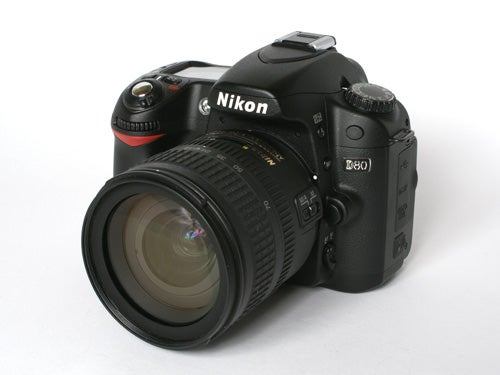
Verdict
Key Specifications
- Review Price: £699.00
The period between the middle of August and the middle of September this year was a busy time in the camera business. In just four weeks Canon, Olympus, Pentax and Nikon all announced new 10-megapixel semi-pro digital SLRs that were so closely matched in specification as to make choosing between them nearly impossible. Add to this the Sony Alpha A100 which was launched two months previously and you can see that Summer 2006 was a hectic few months in the DSLR market.
I reviewed the Sony A100 back in June a few days after its official European launch, and I took a look at the impressive Olympus E-400 two weeks ago. I’m hoping to review the Canon EOS 400D next week, and samples of the Pentax K10D aren’t yet available for review, so today I’m casting a critical eye over the new Nikon D80.

The relative pricing of these competing cameras is interesting. In a kit with a standard zoom lens the Olympus E-400 is available for around £660, the Sony A100 for around £500, the Canon EOS 400D is about £490 and the Pentax K10D is available for pre-order at £700. The Nikon D80 is priced at around £700 bundled with an AF-S DX 18-70mm F3.5-4.5 lens, making it one of most expensive of its current peer group. Given that it’s up against some very stiff competition, especially from the Pentax with its weatherproof body and anti-shake system, is it really worth the money?
If all that was required to sell a camera were first impressions, the answer would be an unequivocal “yes”. Although in terms of size and weight the D80 is closer to the D50, in terms of specification, performance and overall feel it is closer to the D200, something that will be welcomed by enthusiasts.
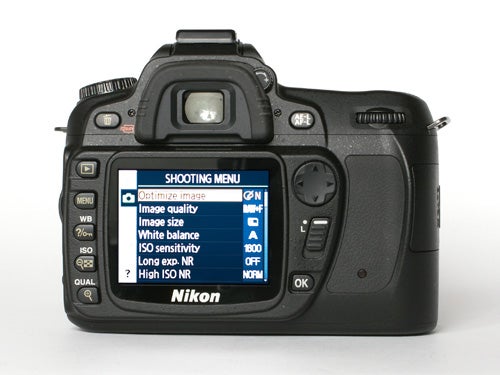
Without its lens or battery the D80 weighs in at a chunky 585g, 30g more than the Sony A100, 75g more than the Canon 400D and a massive 210g heavier than the Olympus E-400. However the weight is well balanced and the camera feels reassuringly solid and steady. Measuring 132 x 103 x 77mm the body is just a few millimetres larger than the D50. It has a plastic shell over what is presumably a magnesium alloy or aluminium frame, and as one might expect at this price level the build quality is superb.
The battery hatch is metal, the card hatch has metal hinges and spring, and the connection ports and remote control connector are covered by tight-fitting dust proof rubber plugs. While the D80 lacks the environmental seals of the D200 or the Pentax K10D, it is certainly tough enough to survive professional use outdoors.
In operation the D80 feels superb. The shutter release action is smooth and light, and the mirror action is quieter and smoother than either the E-400 or the A100. The already popular AF-S DX Nikkor lens focuses quickly and quietly and is a pleasure to use.
The control interface is necessarily complex, combining as it does the high level of exposure control demanded by enthusiasts with some easy-to-use features for less advanced users, including a full-auto mode and a small selection of scene programs.
Compared to the wonderfully quick and intuitive monitor-based control interface of the Olympus E-400, the proliferation of multi-function buttons on the D80 is very complicated, and their layout seems almost random, with some of them very awkwardly placed. I’ve used a number of Nikon SLRs before, but even so I found myself hunting around for things like the flash mode control or the AE lock. With practice of course this will become easier, but it would be daunting for an inexperienced user.
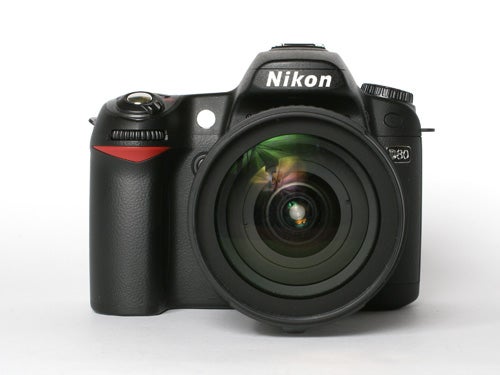
Unlike some other current DSLRs, the D80 has a top-panel LCD display for all the main shooting data. It has a manually-activated backlight, but even so I found that some of the symbols were quite small and difficult to make out in dim light. The data readout in the viewfinder is limited but useful, showing the exposure settings, flash status, shots remaining and exposure compensation level. The pentaprism-type viewfinder itself is excellent, with approximately 95 per cent coverage and optional superimposed grid lines. It is very clear and bright with a nice big focusing screen and dioptre adjustment. I would say that it’s slightly larger than the viewfinder in the A100, and quite a bit bigger than the E-400.
Of course people will buy a digital SLR expecting a wide range of features, and the D80 is absolutely loaded. It has the same acclaimed 3D Colour Matrix II metering and advanced manually-selectable 11-point AF system as Nikon’s top-of-the-range professional DSLRs. Centre-weighted and spot metering are also available, as of course is exposure compensation, but to an exceptional +/- 5 stops in 1/3 or ½ of a stop increments.
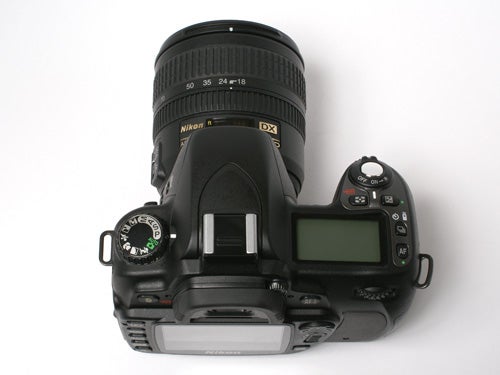
Shutter speeds are from 30 seconds to 1/4000th of a second plus B in all manual modes, and ISO values from 100 to 1600 are available, with three additional settings of H 0.3 (ISO 2000), HI 0.7 (ISO 2500) and H 1.0 (ISO 3200) also manually selectable, although these settings have a separate noise reduction option. Shutter speed and ISO are selected in 1/3 stop increments.
There are six preset white balance options, plus manual setting and dial-in Kelvin colour temperature values, with white balance bracketing. Auto exposure and flash output can also be auto-bracketed in increments of 1/3 to 2 EV.
The D80 also has a large selection of in-camera image editing options in playback mode, including colour optimisation, red-eye correction, cropping, filter effects and D-lighting, which enhances the appearance of shadows in backlit scenes.
Naturally the D80 can shoot in RAW mode, as well as three different JPEG quality settings, and RAW+JPEG with all three JPEG modes. Fine quality JPEG files are around 4MB, and RAW files are around 8MB. The 12-bit RAW files are compressed, but appear to use a lossless algorithm, so image quality is preserved.
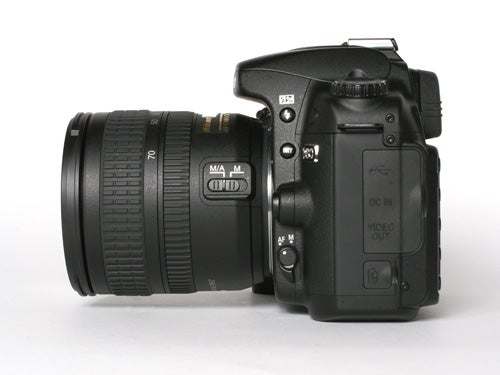
The D80’s performance is predictably outstanding, and start-up is practically instantaneous. In continuous shooting mode it can manage three frames a second. In all JPEG-only modes it can keep this up for around two hundred shots before needing to pause, although in RAW+JPEG mode the buffer can only hold six frames before pausing to write to the memory card.
The AF system is also very fast. I’m sure that someone on a forum somewhere is going to want to know if it’s faster than its competitors, and I’ll have to say that it’s virtually impossible to make that judgement without specialised testing equipment. It certainly seems to me that it’s just as fast as the Sony A100, although possibly a fraction slower than the Olympus E-400. Suffice it to say that focus lag is never going to be an issue. The D80 does have superior low-light focusing though, thanks to a good built-in AF illuminator with a range of at least three metres.
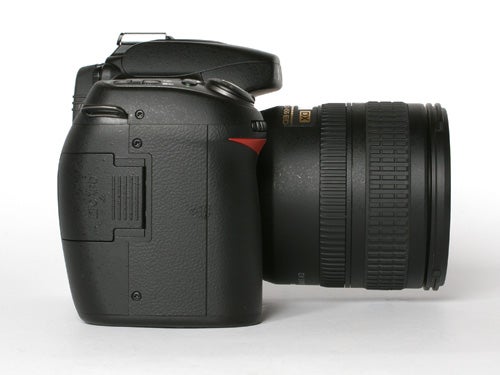
The D80 is powered by a big 7.4v 1500mAh Li-ion battery, and Nikon claims it is good for an impressive 2,700 shots under its test conditions. I can’t confirm this, but after a full charge I fired off around 600 shots over several days in a variety of conditions, and the five-segment battery indicator was reading 3/5 when I was done.
One surprise is the choice of memory card. The D80 uses SD cards only, rather than the CompactFlash cards that are usually employed in high-end SLRs. SD cards are readily available in sizes up to 2GB now, with 8GB SDHC cards promised for next year, but CompactFlash cards are already available in sizes up to 8GB and will probably get even bigger. Considering that when shooting in RAW+JPEG Fine mode a 1GB SD card is only big enough for 54 shots, this seems like a strange and seriously limiting choice for such a powerful camera.
Finally we come to image quality, and here is where the competition really heats up. All of the 10MP DSLRs I’ve tested so far have been outstanding, and the margins between than are so narrow that its almost down to personal taste as to which one is better. In terms of image sharpness the supplied AF-S DX 18-70mm F3.5-4.5 lens gives the D80 a slight advantage. Even at maximum aperture it provides razor-sharp clarity from edge to edge, with barely a trace of chromatic aberration or corner blurring. Stopped down to about f/11 or f/16 its performance is simply superb. The 23.6 x 15.8mm DX format 10.75 megapixel sensor, which is reportedly the same as the one in the D200 and the Sony A100, produces outstanding clarity and detail, so much so that it is virtually impossible to distinguish between shots taken on these three cameras.
The exposure system copes well with sudden and unexpected changes in lighting, but is occasionally fooled by very high contrast shots, such as shooting into the sun, and had a slight tendency to under-expose. Shadow detail is excellent however, so it was possible to correct these shots later in editing.
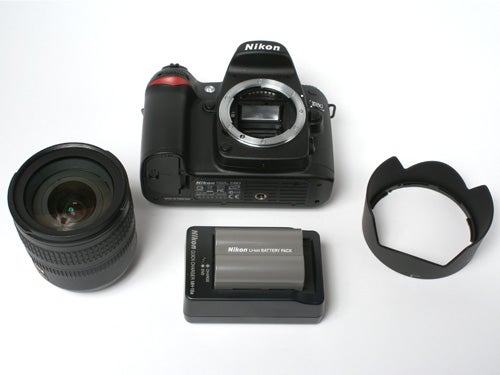
Shooting in RAW mode for maximum quality, colour reproduction is very naturalistic, but can be tweaked in Photoshop Camera RAW converter to produce rich vibrant hues. As with the D200 there is surprisingly little control available from the supplied RAW conversion software, so you’re going to need Photoshop CS2 to get the best out of it.
Having said that however, the quality of the JPEG Fine mode is outstanding, and it takes a keen eye to spot any difference between converted RAW and JPEG Fine images, especially in prints. The in-camera colour and image control makes this a viable option for all but the most demanding professionals.
Image noise control is very good, in fact there is no noise visible up to 800 ISO and only a tiny amount at 1600. As you’ll see from the accompanying sample shots, it has one of the best high-ISO results I’ve seen.
”’Verdict”’
The D80 is another superb camera in Nikon’s increasingly impressive DSLR range. It is expensive and complicated, but it is also extremely well made, incredibly versatile and capable of fantastic picture quality. However it is surrounded by some very strong competition most of which is equipped with shake reduction, and although it may be one of the best 10MP cameras so far, it is not necessarily the best value for money.
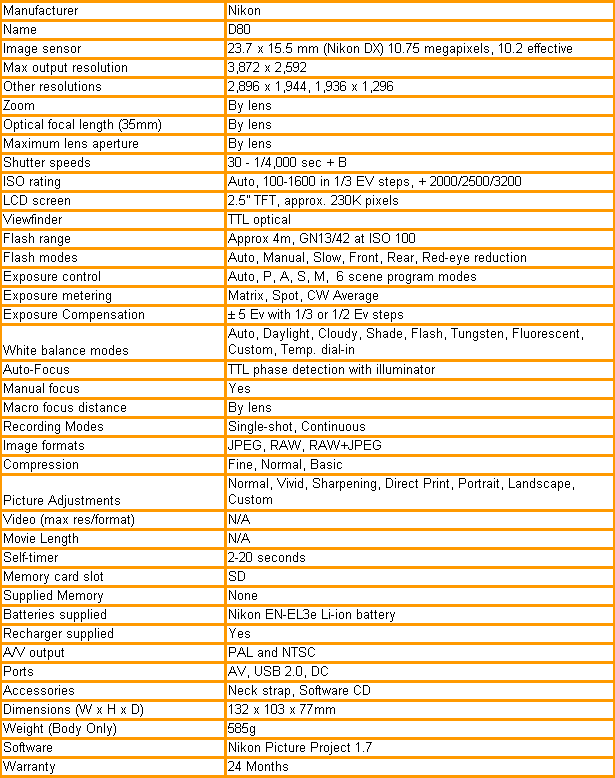
A range of test shots are shown over the next few pages. Here, the full size image has been reduced for bandwidth purposes, and a crop taken from the original full resolution image has been placed below it in order for you to gain an appreciation of the overall quality.
—-
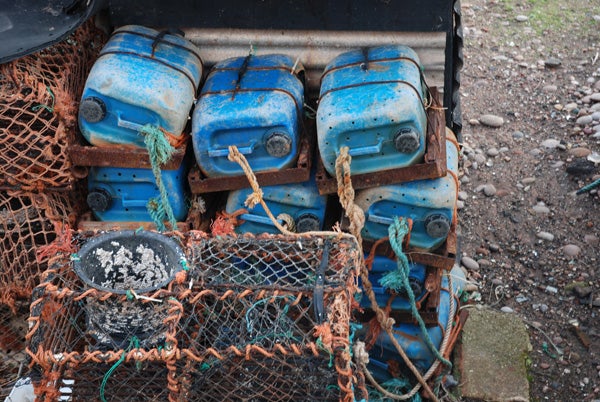
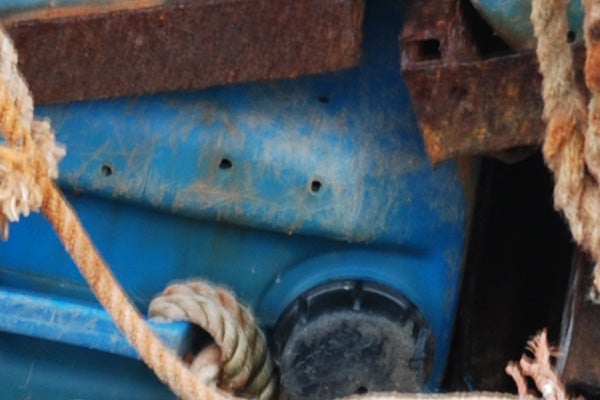
1/2 sec, f/4.5, ISO 100
Unfortunately the long exposure has allowed in some camera shake. However the image is totally free of any image noise.
—-
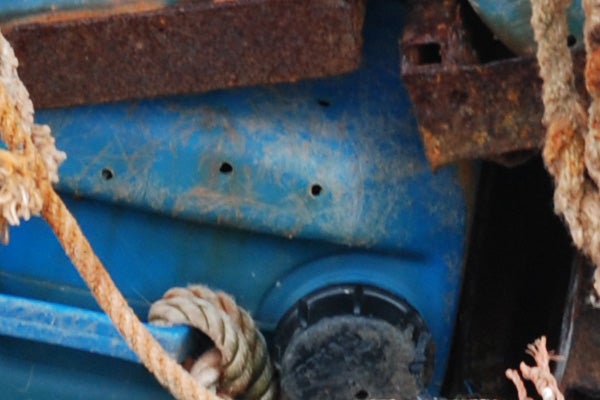
1/4 sec, f/4.5, ISO 200
At 200 ISO the shot is thankfully shake free, and also noise free.
—-
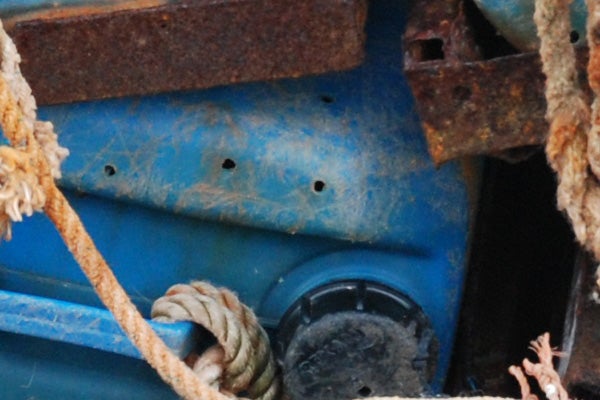
1/8 sec, f/4.5, ISO 400
400 ISO and still no trace of image noise.
—-

1/13 sec, f/4.5, ISO 800
800 ISO and there is still no trace of image noise. The shot is virtually indistinguishable from the previous two.
—-
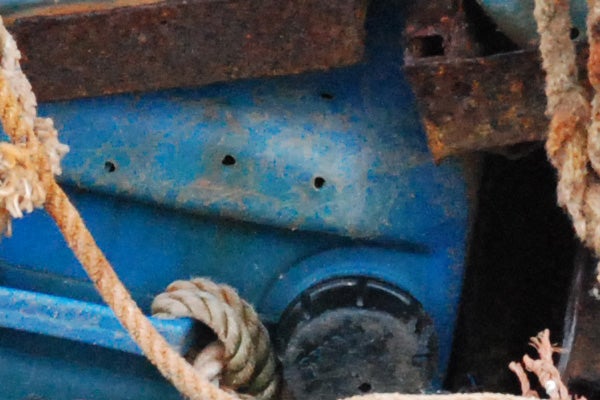
1/25 sec, f/4.5, ISO 1600
At 1600 ISO there is some evidence of noise reduction at work, causing some artefacts to appear around edges and details, but the image is still very high quality and would print well.
—-
A range of test shots are shown over the next few pages. Here, the full size image has been reduced for bandwidth purposes, and a crop taken from the original full resolution image has been placed below it in order for you to gain an appreciation of the overall quality. The following pages consist of resized images so that you can evaluate the overall exposure. For those with a dial-up connection, please be patient while the pages download.
—-
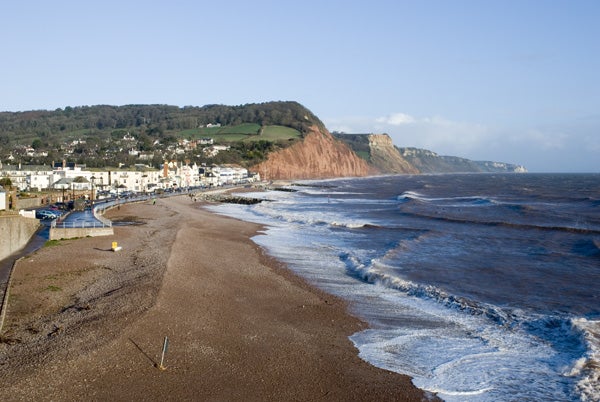
Apart from the slightly better weather, I tried to take an identical shot with the D80 as I did with the Olympus E-400, so that a direct comparison could be made. See the 100% crop below.
—-
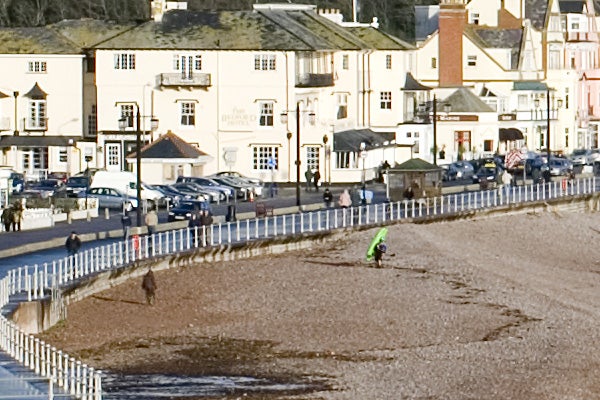
This was shot in RAW mode, then converted to TIFF in Adobe Photoshop CS2 Camera RAW software, given a light shot of Unsharp Mask, and then cropped to the same position as the same shot in the E-400 review. As you can see, the level of detail is fantastic, but is it better?
—-
This page consists of resized images so that you can evaluate the overall exposure.
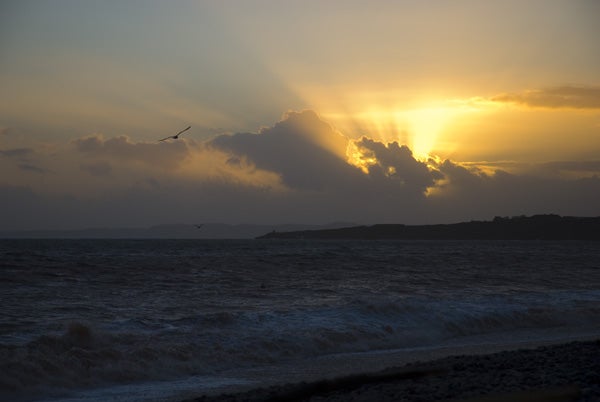
The D80 is capable of fantastic colour reproduction. This was shot in RAW mode, but then converted straight to the JPEG you see here with no modifications.
—-
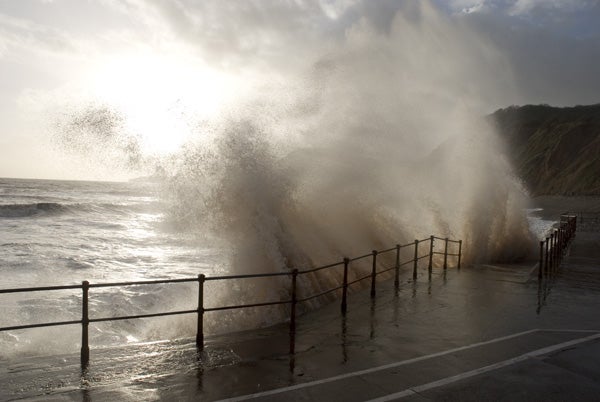
The AF system is plenty quick enough to capture even sudden and unpredictable action like this, but the exposure system has made a bit of a mess of things, burning out part of the sky.
—-
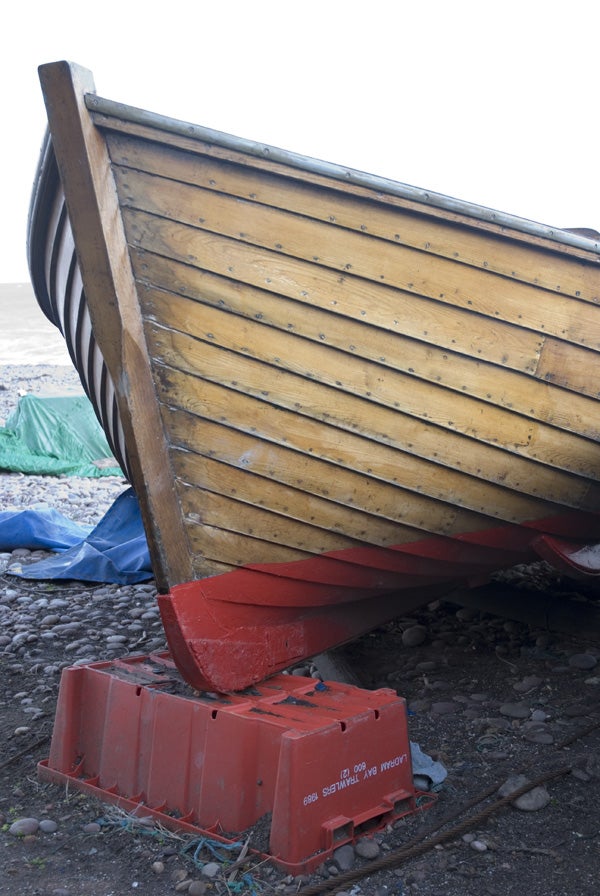
Shot in fading evening light, the colour reproduction and level of detail are still excellent.
—-
This page consists of resized images so that you can evaluate the overall exposure.
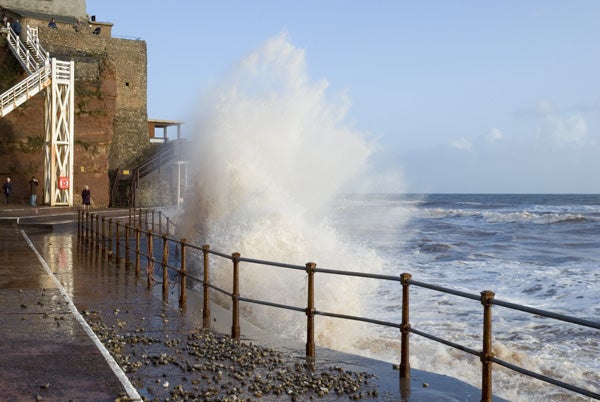
In more normal lighting conditions, the exposure meter is a lot happier and has made a great job of this high-key shot.
—-
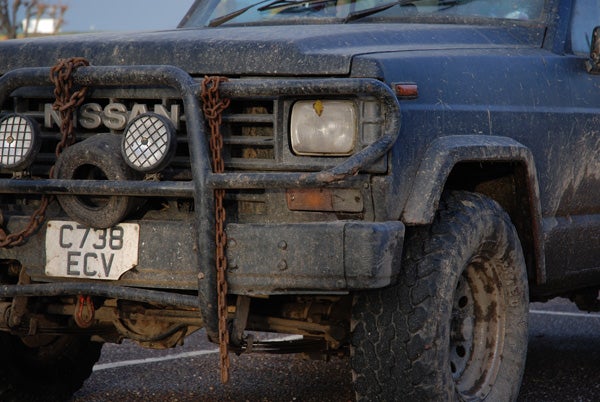
The quick action of the AF-S DX lens is great for framing up spur-of-the-moment shots, and the sharpness, contrast and detail ensure a perfect shot.
—-
Trusted Score
Score in detail
-
Value 7
-
Image Quality 10
Features
| Camera type | Digital SLR |
| Megapixels (Megapixel) | 10.2 Megapixel |
| Optical Zoom (Times) | By lensx |

